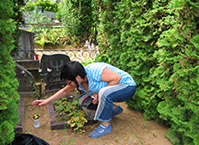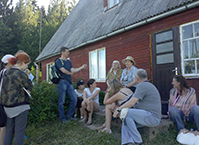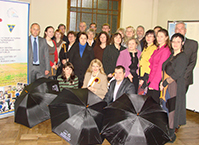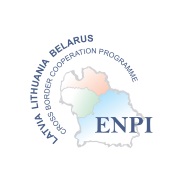The Church choir and preparation for a general holiday of a song and dance in Daugavpils in 1940
Categories: Confessional and international relations, Helena Bilinska
Story-teller: “I liked to sing. You see, in the countryside, there was nothing else, we went to church. And in the church there was an educated organ player, he had arrived from Riga, right after school, such a young guy. He organized the choir at the church. Our church choir was rather big, I think, there were about 40 people. There were some eight basses, tenors – I don’t remember, I think the same number, sopranos might have been about ten, and the altos – the same number. Oh, how beautiful we were singing. But at that time the masses had to be sung only in Latin, not in Latvian, now they sing in Latvian, the masses are sung in Latvian in churches. But at that time, we sang only in Latin. I knew a lot of songs, I could sing nine masses, those were not the same, every mass was different. We sang very beautifully. Rogovka choir was known, we were invited to Aglona twice to sing the Mary’s day choir, we sang the mass in Aglona. You see, I have such nice memories. But, I only speak bout the war.
Then in the year 40, the same organ player prepared us for the Song festival. I also intended to go to the Song festival. I’ll tell you! We needed the right national costumes depending on the region you were from; so that the costume was the correct one. But we were considered belonging to Ludza region, but there was no such a Ludza costume. Then we found somewhere an old journal with national costumes. According to that journal, we had a woman here, who, we had to prepare everything ourselves. To weave the costumes ourselves, one, we were five who were ready to make those national costumes. One, that one woman weaved the skirts. I was among those five who made the blouses. The blouses had to be made not from linen, not from bought linen; we had to weave such a fine cloth, and to sew the blouses by hands. We had to embroider the collar and the sleeves. The buttons for the sleeves had to be made from threads, they were not like simple buttons, they had to be.., I knew how to make such buttons. And we had such striped belts, and those, those head ornaments, we had ribbons in our hair, they were long, down to the very ground. The skirts contained the same number of colours as those ribbons. My skirt contained red, white and purple. What was one more colour?
Interviewer: “Maybe green?”
Story-teller: “The skirts were checked. And thus we gathered there. We went to Daugavpils; that was the Latvian General Song Festival. It was reported that there were eleven thousand singers in the Stropi Forest. People from Kurzeme came, they were very proud, arrogant, they had marten hats, everybody had villaines. We were as the poor, and we were ashamed of everything, but, we thought, what could we do?; we had come from Bērzgale. We were ashamed of ourselves. What to do with that our bitterness; nothing doing, we kept to our district. That time it was the district, yes. But later, when the jury came, they judged everybody, I thought: what would happen! From, from Ludza district we got the first place, I got the first place.”
Interviewer: “Oh, that’s great!”
Story-teller: “I had such a silver sakta and I had such a buckle. The photograph, I had a lot of pictures, but I lost a lot of them during the war. We were then moving to the village, we took everything, and it was raining heavily, and I got into a ditch and wetted everything, thus I lost everything, but I had so many beautiful pictures. I know, that my picture was published in the newspaper, you see, I was photographed like that.”
Images
Audio
Researcher: Dr. philol. Gatis Ozoliņš, Daugavpils Universitāte











